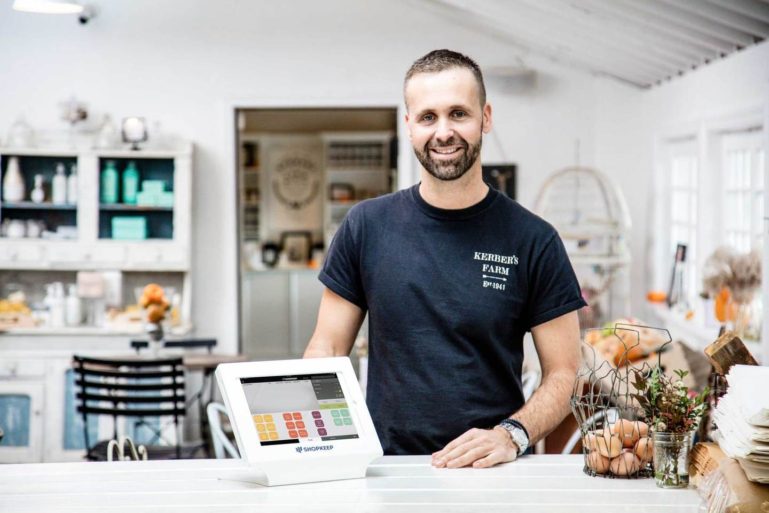
How to Increase Sales in Retail — The Ultimate Guide
There’s probably not a retailer out there who wouldn’t like to see some extra lines on the bottom of their ledger each day.
However, how one goes about increasing sales in retail is often approached with hesitation. Most merchants don’t like the idea of ‘selling’ to their customers. According to the accepted wisdom, more sales will flow from quality customer service and great products than any ability on the part of you or your staff to pitch a product.
The truth is, however, that if you’re not examining the way you encourage your customers to find and buy your products, you are missing out on an opportunity to substantially boost sales and consequently, your bottom line.
A recent Gallup poll asked small business owners to list the biggest challenges they face. Ranking highest was economic issues coming in at 28 percent. Of all financial problems, merchants were most concerned with attracting customers and drumming up new business (14 percent).

So why the aversion to ‘selling’ one’s product? After all, isn’t that the point? You produce or make a great product, shouldn’t you be showing the world its value? You should! But we understand the hesitation in not wanting to appear too pushy. We can appreciate that, so we are here to help.
In this ultimate guide on how to increase sales in retail, we’re going to have you reclaim the art of the sale — through learning the history of sales and the concept of a small business sales funnel. Ultimately, you’ll learn how it all comes together to increase brand awareness, drive demand, and boost revenue — all without appearing too pushy in the process.
A Brief History of Sales and How It’s Changed
For many experienced small business owners, ‘sell’ is a four-letter word. And that’s no surprise. The history of sales hasn’t exactly created the best impression of sales as a skill. But to learn how to increase sales in retail, you need to understand where this reluctance stems from.
Asked to picture a salesperson, most people will conjure up images of used car dealers, boiler room sharks, and irritating telemarketers. For anyone who ever sat down to dinner, heard the phone ring and shivered, you understand the loathing that can be attached to those selling a product and closing a deal. For quite a few years, those pitching, pushing and peddling goods — did their very best to live up to a reputation with aggressive tactics and an exclusive focus on making the sale. Retail store managers taught their staff to use tricks and techniques to persuade customers into making a purchase, whether the product was a good fit or not. Consequently, consumers often felt pressured and ended up making bad decisions.
Salespeople were able to get away with this because of something called the ‘information deficit.’ Back in the day, before the internet, the relationship between buyer and seller wasn’t equal. Merchants didn’t just stock the items and goods customers wanted to buy, they also held all of the knowledge regarding which products were best. They weren’t just vendors, they were knowledge gatekeepers whose advice and support was required before customers could make a purchase. As you can imagine, this made it incredibly easy for salespeople to dictate the terms and push unwanted/unneeded sales.
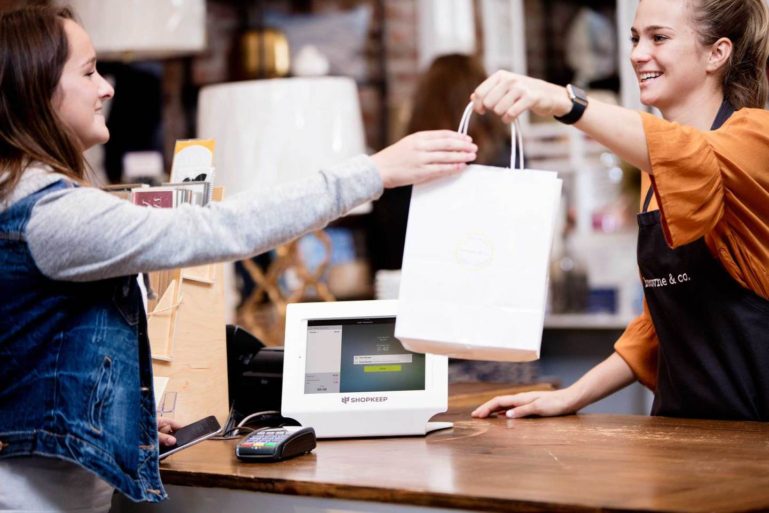
The fact is, this information imbalance just doesn’t exist anymore. The modern salesperson is confronted with customers who have done their research and know the product they’re in the market for. They’ve researched the item they want to buy, read reviews online, and comparison shopped for the best deal in town.
So in addition to the fact that the old-fashioned, aggressive, ABC sales approach has always been unethical, it’s now also completely ineffective.
The Internet Happened, Now What?
Like it has changed so many other things, the internet has revolutionized the world of sales. But what exactly does this mean for learning how to increase sales in your retail store?
It means that with information now at our fingertips and available whenever we need or want it, customers are no longer dependent upon a salesperson (that’s you) to choose the right product for them. Often, customers are doing this all before they even enter your store. So where does that leave you? Well, put bluntly, if you’re still using A-B-C tactics, you’d better hope that the person you pressured into buying that expensive grill, costly sundress, or pricey bottle of wine hasn’t heard of Yelp — because their negative review can potentially cost you dearly with potential new customers.
Stores and merchants that are still using these aggressive push tactics are getting slammed with bad reviews and BBB (Better Business Bureau) complaints. Horror stories online about bad customer service are a dime a dozen. As a result, merchants can have problems acquiring new customers and struggle to keep existing ones.
So what do modern sales techniques look like? To begin with, we now live in a world where 81 percent of shoppers research purchases online before they buy in stores. This means that the biggest change in the world of sales needs to be for merchants to expand their thoughts and strategies upstream in the sales funnel.
This essentially means that if small retailers want to increase their sales, they can’t sit waiting in their stores hoping that customers will magically find them. Instead, shop owners and retailers need to head upstream and guide prospective patrons down the sales funnel. Merchants need to consider the entire customer journey and find ways to engage and support customers at each point, as they seek out information, and as they find solutions to their problems. This process is broadly known as customer acquisition and is often represented as a funnel.

The Small Business Sales Funnel
Before you can execute on how to guide customers through their journey and understand how to increase sales in retail, you need to have a general grasp on what a sales funnel is and how it applies to your business.
In the broadest possible sense, the job of a salesperson has now evolved from a push to a pull mechanism. This means that it’s not about pushing products on customers, it’s about identifying and attracting potential customers that are the right fit for your products and pulling them through your sales funnel — from their first Google search to their credit card hitting your point of sale. We talk about a sales funnel because it represents the idea of a wide initial pool of potential customers gradually whittling down to a few successful sales.
In a nutshell, not everyone who checks you out online will visit your physical retail location, not everyone who sees the front of your store will come inside, not everyone who comes in will engage with your staff, and not everyone who engages with your employees will buy. You’re guaranteed to lose a percentage of potential customers at each stage. Though some depletion is unavoidable, your job is to cast the right initial net and then lose as few customers as possible at each stage of the funnel.
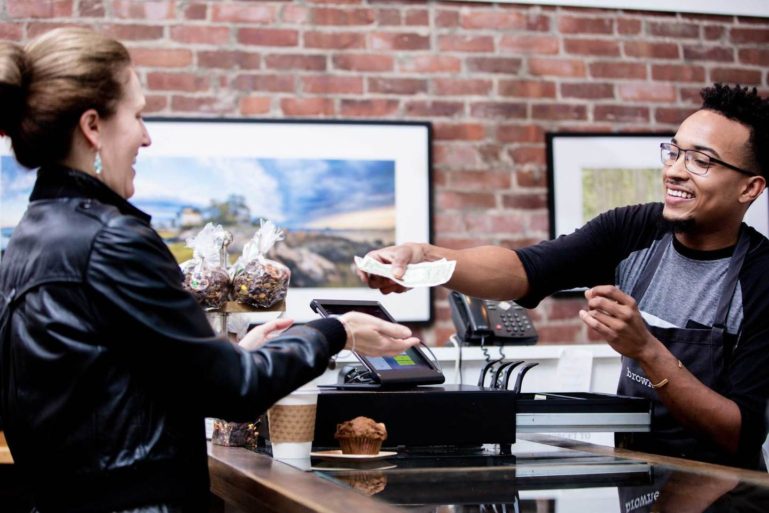
So what exactly does this look like you ask? Good question! Below we’ve outlined a small business sales funnel — as it relates to retailers — to help you picture and understand how and when to engage your potential customers. So, without further ado, here’s each stage of the funnel in more detail:
1. Online Awareness
The first and most obvious job you have as a small business owner is to manage your online presence. That is, all of the people who could potentially become customers of your brick-and-mortar store.
As we mentioned previously, regardless of your industry, more and more individuals are researching their problems online and finding solutions in the ways of products and goods. It is, therefore, vital that you become a part of the solution.
To do this, you need to address three key elements: Reputation management, social media advertising, and content marketing.
Reputation Management
Online reputation management is of the utmost importance in today’s digital age. This includes building out a website that conveys everything that is unique and remarkable about your business. It also means establishing a presence on social media channels and managing the major small business discovery and review platforms such as Yelp and Google. If you haven’t taken ownership and built out your profiles on these sites yet, now is the time. Here are the links to get you started: Yelp for Business Owners and Google Places.
I’ve seen people walk up to a restaurant, open their Yelp app, read the reviews and then turn around and walk across the street because of what they’ve read. Do yourself a favor and manage these forums to your advantage. You’ll be surprised at how much this change can boost sales for your business.
Social Media Advertising
Beyond simply managing your reviews on Google and Yelp, you’ll want to look into using the advertising tools of platforms like Facebook to drive increased foot traffic to your retail store. There are two big reasons why Facebook is such a powerful advertising tool for retailers: targeting and cost.
Facebook collects tons of data about the people using its platform, and it makes that data available to advertisers. So, if you want to target your ads to mothers aged 30 – 37 that live in Nashville, TN with an annual income of $100K who are also interested in gardening, you can do it. This level of specificity helps you get your ad in front of an audience that mirrors your existing customer base, improving the likelihood that it will lead to sales.
Once you get the hang of Facebook’s targeting, you can do other creative things, like advertise to people that are fans of your business’ Facebook page. These individuals are likely already engaged with your business, so you’ll want to promote a different offer than one you might show to someone who hasn’t bought from you yet. For example, you could promote a loyalty program to this audience if you have one. As you might be beginning to guess, the key to success with Facebook is experimentation. Don’t be afraid to test different audiences for your ads, as well as a variety of offers until you hit on a few combinations that are working.
Outside of its targeting, Facebook tends to be more cost-effective than other advertising channels like Google AdWords or even advertising in your local paper. For cash-strapped retailers, the bang for your buck that Facebook delivers can make it an ideal tool for growing your brand awareness and driving more foot traffic to your store.

Content Marketing
While it may be necessary, it’s not enough to just be reactive and manage your online reviews as they come in. Casting a wide net online is about intelligently engaging your target audience. You can’t just sit around and wait for customers to find you.
If people are looking to inform themselves online instead of in store, you simply have to meet them where they already are. This means becoming a part of the conversation online by engaging in proactive content marketing.
It just so happens that you are in luck! Our team takes content marketing very seriously (obviously) and has put together the Small Business Guide to Content Marketing.
Suffice it to say that it can be difficult for small businesses to compete on price, so your survival depends on your ability to add value to the customer’s buying experience. Intelligent, useful, and engaging content is your way of demonstrating the value you will add. And through this, boost your retail sales in the process.
2. Location, Location, Storefront
The second stage of the funnel is the first engagement customers have with your physical location. Because of this, it can be one of the most important aspects of increasing sales in retail for your brick-and-mortar location. Again, it is important to focus on the customer journey and take into account all of the elements that contribute to a customer transitioning from researching online to visiting your store in person. Below are a few of the key aspects to take into account.
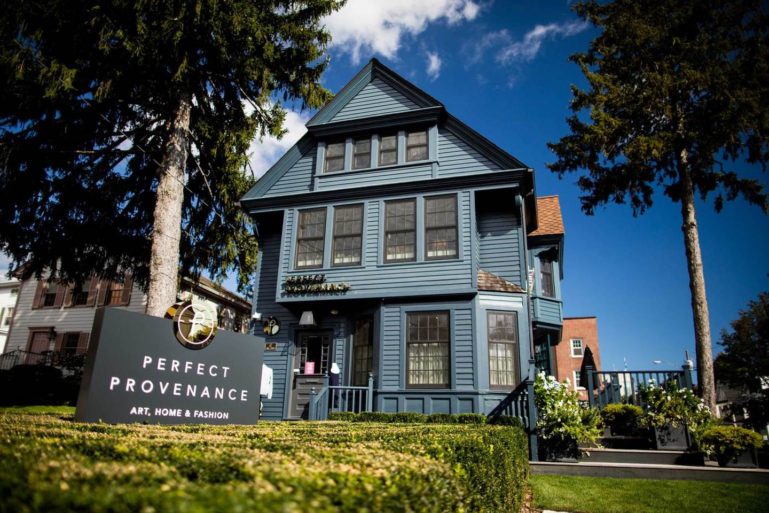
Be Easy To Find
According to the Pew Research Center, 77 percent of American now own smartphones, up from 35 percent in 2011. Though this is an impressive number, what really hits home in this instance is that 90 percent of this group use their smartphones to get directions and business recommendations. That’s huge!
You’ll want to make sure key directories like Google Places, Yelp, Apple Maps, Foursquare, Yahoo and more are up to date with an accurate description of your business, your address, hours of business, and even pictures. It’s free to do, so there’s no excuse. For an added advantage, consider subscribing to a service like Yext to keep your local business listing info up to date across dozens of the different sites potential customers are using to learn about you.
Be Really, Really Easy to Find
If you’re new to owning a small business and have yet to choose your location, you’re in luck!
The world is your oyster and being able to start from scratch and choose an ideal location will have a tremendous effect on drumming up sales initially and allowing you to boost and improve upon sales in the future.
To begin with, you must choose a location that is easy to discover. You’ll want to find a location with a lot of foot traffic. Being on a corner is usually a safe bet, as is having easy access to parking and/or being near the public transportation. Lastly, make sure your signage is large and easy to read. Being creative and having unique branding is great, but if your customer isn’t sure what you sell, the point is mute.

Incentivize People to Come Through Your Door
Increasing retail sales is the name, incentivizing is the game. Seriously, you have to get people in the door. And how are you going to do this? Offering deals that create a sense of urgency (think 25 percent off all sweaters this weekend only), is a great tactic for getting customers in your door ASAP.
If you can’t afford large discounts, that’s ok too. Keeping it simple can be just as effective when it comes to bringing customers through the door. So hand out little samples of soap you’ve just started carrying or even free lemonade on a hot day.
Maximize Your Curb Appeal
Your storefront is the window to the soul of your business, and with it, you can make or break your attempt at increasing retail sales. The look of your storefront should be consistent with both your online and offline aesthetic and should command people’s attention with a visual representation of what your brand represents and what you sell.
You might consider using digital signage or experimenting with different window displays to catch the eye of passing shoppers. Sometimes doing something as simple as moving a few clothing racks out to the sidewalk can be enough to stop a passerby in their tracks and draw them into your store.
SEE ALSO: The Comprehensive Guide to Local Store Marketing
Event Marketing: Create an Experience
An excellent way to increase retail sales and introduce your business to new customers is to create an experience that aligns with your brand.
If you are a clothing boutique, you can use a slow afternoon to offer personal shopping services or provide free manicures to the first dozen customers. If you do these events correctly, you can reward your top customers, creating an awesome viral buzz that will lead to a ton of raving fans.
Events like these can make your brand come alive and allow customers to experience your store in a new and unique way. The more creative that you can be the more memorable the experience you’ll create. Don’t be as concerned about making money with these events. Remember, event marketing is about brand awareness, so you might not see an increase in your retail sales immediately. The goal is to create an experience that wows your customers and drives them to share their awesome experience on social media, leave a great review, and/or tell their friends about how much fun they had.
SEE ALSO: 26 Inexpensive Customer Appreciation Day Ideas
3. Inside Your Store
No discussion of the in-store retail experience is going to be deemed complete without a mention of Apple. So, I may as well get it out of the way right at the start. Apple is awesome, and they have truly cracked the code when it comes to retail design. We all know this. And yet, there are hundreds of small business owners across the country ignoring Apple’s example and losing sales as a result. Do you want to learn how to increase your retail sales? Read and take note.

Perhaps my favorite bit of Apple Store trivia is that if you walk into an Apple Retail Store first thing in the morning, you’ll notice that all of the MacBook Pro notebooks are positioned at exactly the same angle. Employees are equipped with an iPhone app that acts as a level to help them achieve this. It might sound nuts, but this kind of attention to detail is what distinguishes an exceptional in-store experience from a so-so one.
Apple understands that as we walk through the doors of any new establishment, we ask ourselves a hundred questions in the blink of an eye: Is this location trustworthy, clean, friendly? Are the staff likely to treat me well? Will the merchandise be to my liking? Will I find what I need and complete my purchase quickly? Will the prices be too high, too low, or just right? And, perhaps most importantly, is there anything different and distinctive about this place? Does this feel like my kind of store?
Your job as a small business owner is to make sure your store is answering these questions. The overall goal of this section of the small business sales funnel is simple:
Every single person who walks through your doors should spend money in your store. Easier said than done, right? Yes, you’ll never get 100 percent of your visitors to spend, but by providing the best in-store experience possible, you’ll maximize your chances to acquire new customers and boost sales in the process.
SEE ALSO: 10 Store Design Ideas that Save Money and Boost Sales
So how can you make your in-store experience world class and get customers opening up those wallets? The first step is acknowledging that process of creating the perfect in-store experience – often called visual merchandising – is part science and part art. When it’s done best, it’s a perfect marriage of form and function, in which every aspect of your space conveys a consistent look and feel and facilitates a smooth and enjoyable customer journey.
Here are a few key elements to consider:
Counter Position and First Impressions
For most stores, the counter remains the central, beating heart of the store. Regarding your store layout, all roads should lead to Rome, with all aisles and walkways driving towards the point of sale.
Ideally, your counter position should also give you a clear line of site on your store’s entrance and exit. This will give you a chance to greet customers as they arrive and establish the right atmosphere from the onset. It will also give you the opportunity to thank customers as they leave (and has the added benefit of deterring shoplifters, who prefer to be able to grab and exit without going past the cashier.)
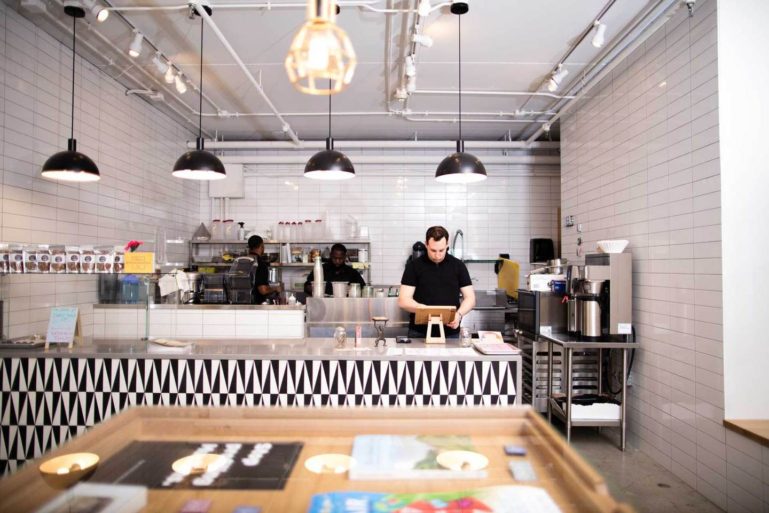
Signage and Guiding the Customer Journey
As with all elements of your in-store experience, the best signage is a hybrid of form and function. Functionally, it should provide clear guidance that helps customers find what they are looking for. This should include providing signage for products themselves, as well as miscellaneous items like restrooms, or an indication of which way to line up at your point of sale. The best signage, of course, doesn’t just help customers find what they’re looking for but also inspires them to want something they never knew they needed. Cha-ching! If you can learn how to accomplish this, you are well on your way to learning how to increase sales in retail.
The key with in-store signage of this kind is to consider how much time people are likely to spend in the each area of your store and target your message accordingly. At the front of your store, you’ll want to go with bold, simple, visual messages that give a broad insight into who you are and what your business offers. If you are going to offer promotions here, they should be straightforward, for example, 15 percent off all T-shirts.
At the point of sale, where people are potentially waiting in line, you can afford to provide more copy-heavy messages and more elaborate promotions. For example, the counter is the perfect place to advertise your loyalty program. It’s also an excellent idea to train your staff to mention the program during the checkout process to prompt signups.
The point of sale is also a great place to use cross-selling tactics. You can arrange a variety of small, lower-priced products at the counter to guide shoppers towards purchasing more than they originally intended. Think about the last time you were at the pharmacy. What did you see at the counter? I’m guessing there was an assortment of small items like lip balm, candy, and gum. Did you grab a pack of gum and add it to your purchase without even really thinking about it? An impulse purchase like this is called an incremental sale. Replicate this strategy in your own store to increase the size of an average purchase.
Sure these products might only cost a dollar or so, but if you ring up dozens or more transactions a day/week, these smaller purchases can add hundreds to thousands of dollars to your monthly revenue.
SEE ALSO: Eat Here or We Both Starve: Cool Chalkboard Marketing Ideas
Information, Authority, and Trust
As discussed at the start of this guide, customers are now coming into your store more informed than ever before about the products they need. As such, they expect you and your staff to be even more up to speed and informed on the products they’re looking to buy. It should go without saying that you, therefore, need to train your staff to know your product line inside and out. Along the same lines, how do you convey this expertise to your customers?
As with the content marketing approach, use in-store signage and a customer-centric approach to conveying authority on the subject at hand.

Ever wonder why the guy in those old toothpaste advertisements was wearing a white coat? Of course not. He was made to look authoritative so you would trust his recommendations. Perhaps the best retail example I’ve seen of this is the yoga apparel company, Lululemon. The walls of this store are often home to pictures of their staff performing challenging yoga poses. They also post schedules showing where their staff will be attending and/or teaching yoga classes in the neighborhood. This positions the staff as both insiders and experts whose advice can be trusted.
Don’t underestimate the simple approach here. Make sure your staff reflect the diversity of your potential customer base and then make it clear that your staff are personal devotees of your product. This allows your customers to identify with your products on a deeper level. This deeper connection is essential for increasing sales in retail.
Make Your Store a Destination
To further increase sales in retail, consider converting your business from a simple store to a destination. Doing so gives you a leg up on online retailers that may offer lower prices, but lack that community feel. To achieve this, offer amenities that make the shopping experience more pleasant. This not only drives more foot traffic, but it can keep shoppers in your store for longer, increasing the likelihood that they’ll make a purchase or increase their purchase size.
Some amenities to consider adding include free wifi, charging stations for smartphones, comfortable seating, and a free beer or wine if it aligns with your brand and target audience. You could even tie your events into this strategy to offer things like classes or free consultations. If you’re a quilting or crafting store, for example, you could offer free sewing or needlepoint classes as a way to attract shoppers. Depending on how much you want to invest in teaching, you could even start charging for these classes, turning them into a supplementary revenue stream.
Customer Service and the ‘Wow’ Moment
Getting people into your store is a huge part of the challenge of increasing sales. That’s why every person who comes through your door should be treated like a cherished resource. Greet people as they come through the door, find out what they need quickly, and go out of your way to make their experience a personal one. As a rule, if someone wants a bland, in-and-out experience they’ll visit a big box retailer. But, if they’ve come through your door, you are safe to assume they want a unique experience. It’s up to you to figure out how to give them exactly that.
SEE ALSO: Here is How to Keep Your Customer Retention Rate High
Above all else, your mission at this stage of the funnel is to provide a fantastic customer experience, coupled with incredible customer service. There is nothing that isn’t worth trying. For as long as time, retailers have been experimenting with design, layout, color scheme, music, smell, signage, staff uniforms, and more — to delight customers and encourage them to take out their wallets. Remember, you won’t know if something works until you try it out. So, take up the challenge and see what you can do to make your customers say, “WOW!”

4. At the Point of Sale
Small business owners obsess about bringing new customers through the door, but the fact is, the customer standing right in front of you is probably your most underexploited resource. How many customers walk out of your store having spent all they were willing to pay? How many are so enamored with their experience that they’re going to tell their friends? How many are going to come back in tomorrow? Or in a week’s time?
It might seem that the small business sales funnel would finish at the point where you greet the customer at the counter to process their transaction, but there is so much more opportunity to take advantage of here. By exploiting the opportunity that is right in front of you, you know that you are getting the most value out of each customer.
There are four core goals that your staff should be pursuing at the point of sale in order to increase your retail sales and boost profit:
- The Upsell
- Word of Mouth
- Email Receipts
- Repeat Customers
The Upsell
Upselling is truly an art. Suffice it to say, that if you don’t train your staff on how to upsells more customers, you are leaving money on the table. For any retail merchant that needs to see a speedy uptick in sales, implementing proper upsell training for their staff is probably the most efficient available in terms of boosting sales.
The next three of these goals are best understood as how you can turn the small business sales funnel into a cycle of repeat business and ongoing growth. They are also addressed in more detail in the 7 Steps to Sales Success below.
7 Steps to Sales Success
1. Make People Happy
Your customers should love coming into your business. A potential customer should feel happy the moment they walk in. There should be a welcoming atmosphere that invites people in and encourages your staff to interact with potential customers. It’s important to note that your employees are your most valuable asset as they create the experience that your customers remember. Going forward, remember this: Happy employees equal happy customers equals an increase in retail sales.
So how do you produce happy employees? The best way to ensure that your employees love coming to work is to understand their personal goals. The primary responsibility of a successful manager is to help their employees achieve their professional objectives. To unlock the highest potential of your employees, show that you care about them and that you genuinely want to help them realize their goals. Once you understand your employees’ personal goals, you can align your company objectives properly. By creating the proper alignment, you will have happy, motivated employees who will reward you with hard work and who will be excited to take care of your customers.
SEE ALSO: How to Hire and Keep the Best Employees for Your Business
Why is this so important? Well, who would you rather buy something from? Someone that hates their job and is miserable or someone that loves their job and has a smile on their face? Ultimately, your employees are responsible for creating the in-store experience for your customers. If they love what they do, it will reflect in their demeanor and the level of customer service they provide, ensuring the highest possible lifetime revenue per customer.
2. Invest in Training
So now that you know your employees’ goals and have created an exceptional work environment, it’s time to train your one-of-a-kind team.
First and foremost, it’s essential to communicate your expectations to your employees. You want — no need — to have everyone on the same page and know what to expect from each other. It’s important to address the following:
How do you expect your employees to treat customers?
How fast do you expect someone to ring up a transaction?
What is the process of ringing up transactions?
How much revenue is each employee expected to generate?
What are the performance expectations of each role?
Does staff have the potential to earn bonuses for excellent performance?
If not, how will you reward awesome performance?
Once you’ve set expectations, it’s time for your employees to learn their job. Outline their roles and responsibilities and walk them through every step. Each employee should have a high-level orientation as well as at least one training that is more specific to their role.
Note: It’s crucial to remember that what might seem intuitive or obvious to you probably won’t be for your employees. If in doubt, spell it out.
Before your employees interact with customers, it’s important to role-play common scenarios. Define the most common customer types, questions, conflicts, and issues that they will face each day. Then, role-play different scenarios. Give feedback and repeat as necessary until you feel that your staff has an adequate grasp on how to properly represent your business.
Meetings and touching base with employees are important not just for CEOs but also small business merchants. Set up either a weekly or monthly meeting where your staff gathers to discuss what’s working well and what needs to be improved.
Each employee should be laser-focused on doing their job better each day than they did the last. If they know that doing their job well will help them achieve their personal goals, they’ll be motivated to improve. The more open and honest this communication is, the greater the chance you’ll improve the operations of your business and consequently boost your sales.
Lastly, sales train and role-play with your customer-facing staff on a regular basis. Each time that you receive a new product, sign on with a distributor or switch up your pricing strategy, you need to train your staff on how to communicate this to your customers.
Customer communication is key to creating a great experience and is integral to learning how to increase sales in retail.
3. Engage Your Customers
Have you ever been to Home Depot? I’m constantly shocked by how they stay in business. Nothing is easy to find in that store, it always appears eerily empty because of the store’s size and finding an associate is like finding Waldo.
Now, have you ever been to an Apple Store? If you have, you might understand why it’s the most profitable retail store per square foot in the world. According to research and consulting firm Retail Sails, Apple Store makes more than $5,500 for every square foot of store space, more than twice that of Tiffany & Co. that maxes out at $2,951.
In addition to the beautiful store design and layout of Apple, they have friendly smiling staff who greet you immediately. This is crucial. Each person comes into your store for a reason, and each person could potentially purchase something and support your business, so smile and greet them. Ask them if they are visiting your store for a specific reason or if they just came into browse. This is an excellent way to understand your potential customer’s motivation. But, regardless of their intentions, each customer should be treated the same, because every person who walks through your doors could turn into a loyal customer.
Remember, each interaction is an opportunity for you to serve your customers, nurture a relationship, and make a sale. The key is to test new greetings and new opening lines when welcoming customers. Find out what works for your store and constantly iterate based on sales data and customer feedback.
4. Value Before Price
The number one factor to increasing sales in retail is explaining the value of your offering before the price is revealed. We understand that this is difficult to do when prices are displayed all over your store. However, think about an example where there typically isn’t a price mentioned and it is often the most expensive item available — the good ol’ restaurant special.
How many times do you ask the price of a restaurant special before ordering? Many times you simply order the special because it sounds delicious. But why would you do this if you don’t know the price? Well, it sounded delicious and therefore the value was communicated to you immediately.
Essentially, you didn’t need to hear the price because in your mind the price had already been justified by the value.
Though it’s slightly more challenging in a retail location, it is possible to create a similar reaction. The first step is to train your staff to be able to communicate to any potential customer why paying a certain amount for an item in your store is indeed a smart move. But before they can do that, your employees themselves need to understand the value of the products your business sells. This all comes back to proper training and making sure your staff is familiar with the brand and mission of your business.
To keep your staff on their toes, we recommend role playing. Take 15 minutes before each shift and run through hypothetical buying situations with your employees, having them pitch you on exactly why a certain product is worth your investment. They should be able to explain to you why you should buy that item and why the price point is right on target.
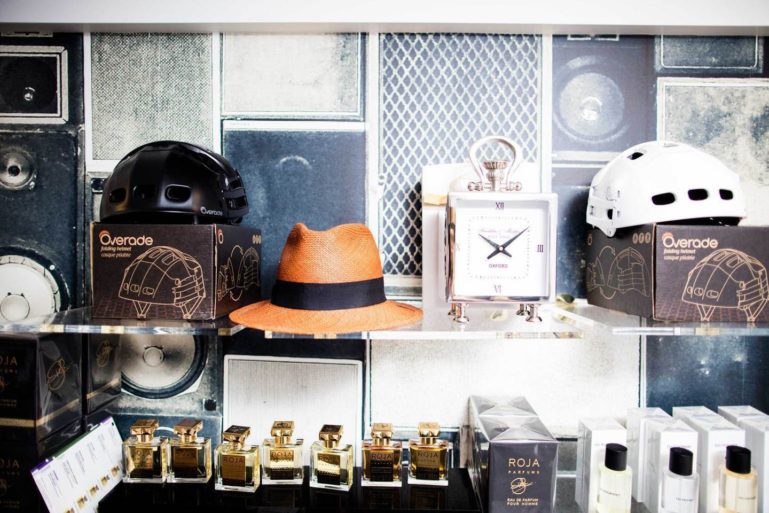
5. Increasing the Order Size
Upselling is one of the best ways to increase revenue in your store. If you feel at a loss for exactly how to increase sales in your retail establishment, mastering the art of the upsell is a must. By definition, upselling is selling more product to a customer who already has intentions to buy. Since the individual is already in the purchasing mindset, upselling to a person, opposed to nurturing a new sale, is significantly easier. But how exactly do you upsell someone?
Here are a few phrases to help move the upselling process along:
“If you like this, I think you’ll love this.”
This suggestive sell technique is a great way to bundle items together and increase the number of items purchased. The important thing to remember is to be making connections between like or similar items. If you notice that a customer is gravitating to deep gem-colored tones, make sure you aren’t recommending an item in bright canary yellow. Your customer will be caught off guard and it will be obvious that you are recommending products simply for the sake of hoping they will make an additional purchase.
This tactic works best when you have a well-trained and knowledgeable staff, one that builds rapport with your customer. The key here is to train your staff on what items you should recommend together. The best advice that I’ve ever received in sales is that the worst you’ll ever hear is no, so it never hurts to offer up a recommendation.
SEE ALSO: 6 Ways Retail Business Software Can Simplify Your Life
“Excellent choice. Have you thought about this one?”
This is a great way to increase the amount spent at your store by upselling to a higher priced item. For example, if you are a retail shop and a customer wants to buy an $80 dress, your sales associates should be trained to say:
“That is a great choice. If you like this dress you might also like this one. It has a similar cut and is extremely flattering.”
The product that you recommend at this point should be priced slightly higher (around 25 percent higher than the original item — test the exact figure with your customer base).
At this point, one of three things will happen. They will buy the original dress for $80. They will buy the more expensive dress for $100, or they will buy both for $180. By recommending the higher price item you now have a 66 percent chance that you will make more than the initial $80. Not Bad, huh?
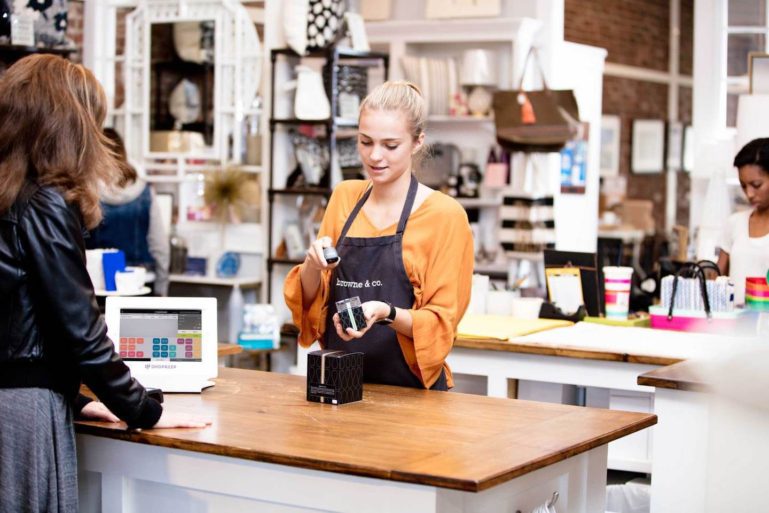
And finally my absolute favorite — the option close.
This works perfectly in a couple of different scenarios. If you have a customer that simply cannot decide what they want, recommend two options.
“Based on what you are looking for I’d recommend either Option A or Option B. Which do you prefer?”
The power of this question is that it simplifies the decision for the customer. No longer do they have to analyze an endless array of different options which can be overwhelming and lead to decision paralysis. They now only have to pick one — and the “prefer” angle forces them to pick what they like better, which is much easier for someone to decide. Combining this with one of the upsell techniques above is a great way to increase money spent per customer.
This also works very well when someone already has decided to purchase from you. Let’s say you have a customer that just ordered a coffee. You could train your staff to ask:
“We have two items that go really well with that coffee. A delightful muffin made with fresh organic honey or an applesauce donut that is the best thing I’ve ever tasted — which would you prefer?”
Or maybe you have a customer that just ordered a burger and fries. You could train your staff to ask:
“What would you like — a soda or a beer with your burger?”
Please keep in mind that this a more assumptive closing technique and must be trained properly. The key is to ask this in a very friendly and personable manner. If your staff doesn’t do this properly, it can cause an awkward or off-putting customer experience. Use wisely!
6. Creating Urgency!
There are three main ways of creating urgency. You incentivize your staff to sell more, you incentivize the customer to buy more, or you train your staff on uncovering pain points.
One: A great way to drive sales is to motivate your team to sell. You can do this with a contest that rewards the person who sells the most with a $50 gift card or a paid day off. The better you know your employees, the better you will know what they respond to.

Two: Another way to create urgency is to provide an offer to each customer that comes through your door. Provide a coupon for a certain percentage off for whatever they purchase that day. You could also offer a free item with a purchase. It’s important to get creative, try out different tactics, and see what works to boost sales for your business and what doesn’t. Remember, this works best in conjunction with a friendly, outgoing, and happy staff.
Three: Pain points are problems that your customers are trying to solve. By asking the question early “What brings you in today?” you can understand why they are in your store. Your goal then is to simultaneously increase your sales while helping them solve their individual obstacles.
7. Post-Purchase Communication
Now that you have generated a new customer, it’s important to communicate with them post purchase. The goal with each new customer is to figure out ways to increase their lifetime value (LTV) to your business. You can only really do this in two ways: Increase their average order value (upselling in store) or increase the frequency of how often they purchase from you.
It’s very important that you have a method in place at the point of transaction to engage with your customer and obtain as much information about them as possible. We recommend first snagging their precious email. Most quality POS systems allow you to build your customer database by collecting email addresses at the point of sale.
By collecting addresses, you’re then able to tie purchases to specific individuals and keep a record, chronically what items certain customers regularly purchase.
Each transaction will be tied to an email so you can start to build up a picture of what each specific customer comes to you to buy. If you’ve ever purchased on Amazon, personalized recommendations based on your past spending habits are probably familiar to you. Think about how that compares to the current in-store experience you’re offering. What sort of personalizations are you able to offer? How many people that come into your store could you actually recommend something to without first speaking with them first?

Most independent brick-and-mortar stores have very little data on who their customers are and what they buy. Grabbing an email address is your first step to changing this. Once you have their email, you can start to communicate with these customers to increase their engagement with your store, encourage them to return, and ask them questions that will improve your business.
Your first post-purchase communication should be an email thanking them for choosing to spend their hard-earned money in your store. I recommend that you also take the opportunity to ask them to rate their in-store experience. SurveyMonkey provides some easy tools that you can use to collect this kind of data via email.
Alternatively, you could drive them to leave you a review on Yelp. As with all things, the key here is that you try different calls-to-action (CTA) and assess which works best for your business.
Regarding ongoing communication, it is important that you respect your customer’s inbox. Even though the returns on email marketing are astronomical, nobody likes to be spammed. So, make sure to communicate sparingly and with an emphasis on quality content. Nowadays, many small business owners are using content marketing to remain in touch with customers without seeming overly ‘salesy.’ If you’d like to learn more about content marketing, you can read our comprehensive Guide to Content Marketing.

If you communicate in this way, when you do send that sales promotion, you’re likely to get a better response. As a promotional trial, I’d recommend asking customers to take action in exchange for a free item coupon, such as liking you on Facebook. Getting them to like your page gives you another way to communicate with your customer and collect data on customers including basic demographics, the location of your customers, and information on what their favorite products are.
SEE ALSO: Small Business Guide to Social Media
Have a Plan to Measure Success
In the words of the legendary Peter Drucker, “You can’t manage what you don’t measure.” As a retail business owner, you’ll never know if your sales and marketing tactics are working if you don’t measure their effectiveness. Here are a few basic metrics to help you do just that:
Number of Shoppers or Customers
It almost goes without saying, but one of the key ways to increase sales in retail is to grow the number of shoppers that enter your store. Of course, you’ll also want to increase the number of those shoppers that actually make a purchase, too. Calculating your number of customers is straightforward, simply add up the number of transactions from unique customers that occurred during the day.
Calculating the number of shoppers is a little more manually intensive. You’ll need to keep track by hand, using a clicker or by keeping tallies on a sheet of paper. There are also smartphone apps designed for this purpose.
While these metrics are pretty basic, they’re definitely valuable for getting a high level view of how effective your efforts are at increasing foot traffic and purchases. You could also look at your total sales for the day, week, etc. as another way to measure your efforts at a high level.
Sales per Square Foot of Selling Space
This metric can give you good insight into how well you’re utilizing your space. To calculate this metrics use this formula:
Total Sales / Square Feet of Sales Space = Sales Per Square Foot of Selling Space
Tactics like in-store signage, engaging product displays, and sales training for you staff can all improve your sales per square foot.
Sales Per Employee
This metric is particularly valuable if you have employees that actively sell to shoppers in your retail store. While there’s some value to looking at the average sales value an employee adds to your business, particularly if you’re considering increasing headcount, we believe it’s more important to evaluate each employee on an individual basis.
Doing so will give you greater insight into the impact that each employee has on your business’ success. If you roll out sales training for your staff, this can also be a way to measure its effectiveness. Most POS systems automatically link purchases to an employee’s account making this an straightforward metric to track. If you’re using paper tickets or a traditional register, you’ll need to track this data manually.
Average Sale Per Customer
If you’re making an effort to up-sell and cross-sell shoppers, this metric can tell you if your tactics are working. To calculate this metric, use this formula:
Total Sales / Number of Customers = Average Sale per Customer
First, establish a baseline value for average sale per customer, then begin implementing your upselling and cross-selling program. After some time passes (The amount of time you wait depends on your transaction volume. A lower transaction volume means you’ll need to wait longer before evaluating. The opposite is true is you transact at a high volume.), measure again and ideally you’ll see an increase.
There are, of course, dozens of different metrics you can use to measure the effectiveness of your sales and marketing strategies, but the ones above are a good starting point.
It’s important to note that one of the keys to using metrics to manage your business is to calculate their values before you change anything. This gives you a baseline number to compare against as you adopt new sales tactics. If your financial situation allows for it, try to test a single tactic at a time instead of making several changes at once. When you test a single tactic, it’s easy to see if the specific change you’re making is having a positive impact. If you change several things at once, it will be basically impossible isolate the tactic that’s driving your success. This makes it harder to optimize things going forward.
Leverage the Power of Point of Sale
Throughout this post we’ve given you dozens of actionable tips for growing sales in retail. However, without the right tools in place it’s impossible to maximize their effectiveness. This is where a modern and affordable iPad point of sale (POS) like ShopKeep comes in.
A Superior Customer Experience
An iPad POS simply makes your store a better place to shop. It’s easier to checkout customers with a POS than a regular cash register, preventing long lines and irritated shoppers. It’s usually faster to train your staff to use a POS, allowing them to focus on delivering great customer service versus just trying to learn the ropes.
You’ll also get access to the latest payments hardware, meaning you can accept in-demand payment methods like Apple Pay. Lastly, the modern, sleek look of an iPad POS is an easy way to improve the aesthetic of your store when compared to a clunky, old fashioned cash register.
Integrated Marketing Tools
Outside of improving the customer experience, a POS system gives you a variety of tools that help you grow sales. For example, you can use your POS to collect customer email addresses that you feed into your email marketing platform and send promotional messages, driving repeat purchases.
It really depends on the POS you use, but many offer you ways to promote your social media channels on emailed receipts. You might even have the ability to sell gift cards, which is a great way to increase purchases. Not only are these great products that give indecisive shoppers something to buy for birthdays and holidays, but there’s data that states the recipient will likely spend more than the value of the gift card when they visit your store. According to Gift Card Granny, 65% of gift card holders spend an extra 38% beyond the value of the card.
Powerful Analytics Reports
Perhaps most importantly, a modern POS system will give you powerful analytics and reports that offer you deep insight into your business. This allows you to make informed decisions that lead to smarter investments and increased sales. Here are a few examples:
Inventory reports – These reports can help you perform critical tasks like identifying best and least selling products, so you can invest in stocking more of what’s driving revenue for your business.
Staff reports – Easily identify your top salespeople and schedule them during peak hours to drive increased sales for your business.
The other great thing about an iPad POS is that it’s cloud-based. This means that you can access all of your transaction history, sales data, and reporting wherever you are, as long as you have an internet connection. For a busy retail store owner, that flexibility is hard to beat.
If you feel a lot has been covered in this post, you’re right! You might even be feeling a little overwhelmed about taking on all of these tactics at once. But that is where we are going to step in and stop you. Just because we have made all of these recommendations doesn’t mean you should (or need) to adopt all of them. That’s the beauty in learning how to increase sales in retail, small periodic changes can lead to lasting exponential growth.
As a small business owner, you know that there are only so many hours in each day, and each of one of these hours is precious. So take some time, read through our recommendations again, and choose one or two tactics to begin with. Implement these tactics, evaluate the outcome of each, then rinse and repeat. When you have time, implement a few more. But regardless of where you are in your business, know that these tactics are there to fall back on. Applied correctly, they can be your key to a healthier and more prosperous business.
Want to try ShopKeep for yourself?
Just answer a few easy questions.
Need help finding the right point of sale?
Just complete the form. We’ll call you right back to explain how ShopKeep can work for you.
Hit the ground running.Sprinting, in fact!
Read our free, comprehensive guide, Small Business 101, to learn all you need to know about starting a thriving business.

